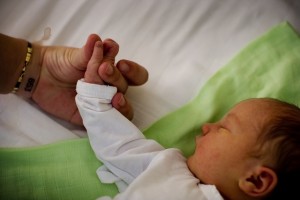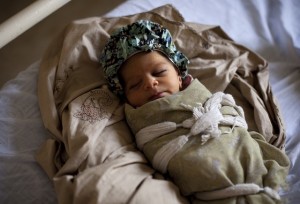Almost 3 million newborns could be saved each year
2014-05-20
NEW YORK/ HONG KONG, 20 May 2014 – A ground-eaking series of papers released by The Lancet at UNICEF Headquarters today shows that the majority of the almost 3 million children who die before they turn one month old could be saved if they received quality care around the time of birth – with a particular focus on the most vulnerable and under-served.
Newborn deaths account for a staggering 44 per cent of total mortality among children under five, and represent a larger proportion of under-five deaths now than they did in 1990. These deaths tend to be among the poorest and most disadvantaged populations.


|
“We have seen tremendous progress in saving children under five, but where the world has stumbled is with the very youngest, most vulnerable children,” said Dr Mickey Chopra, head of UNICEF’s global health programmes. “This group of children needs attention and resources. Focusing on the crucial period between labour and the first hours of life can exponentially increase the chances of survival for both mother and child.”
According to UNICEF, 2.9 million babies die each year within their first 28 days. An additional 2.6 million babies are still-born, and 1.2 million of those deaths occur when the baby’s heart stops during labour. The first 24 hours after birth are the most dangerous for both child and mother – almost half of maternal and newborn deaths occur then.
The Lancet’s Every Newborn series identifies the most effective interventions in saving newborns, including breastfeeding; newborn resuscitation; ‘kangaroo care’ for premature babies – that is, prolonged skin-to-skin contact with the mother; and preventing and treating infections. More funding and adequate equipment are also vital.
Countries that have made the most progress in saving newborn lives have paid specific attention to this group as part of the overall care extended to mothers and under-fives. Rwanda – alone among sub-Saharan African countries – halved the number of newborn deaths since 2000. Some low and middle-income countries are making remarkable progress by, among other methods, training midwifes and nurses to reach the poorest families with higher quality care at birth, especially for small or ill newborns. |
A survey of 51 countries with the highest burden of newborn deaths found that if the quality of care received by the richest were to become universal, there would be 600,000 fewer deaths per year – an almost 20 per cent reduction.
The highest numbers of newborn deaths per year are in South Asia and sub-Saharan Africa, with India (779,000), Nigeria (267,000) and Pakistan (202,400) leading. For the highest burden countries, every HK$7.8 (US$1) invested in a mother’s or baby’s health gives a nine-fold return on investment in social and economic benefit.

|

|
UNICEF and World Health Organization will roll out next month the Every Newborn Action Plan which aims to end preventable maternal and child deaths by 2035.
The Lancet’s Every Newborn series is co-authored by experts from UNICEF, the London School of Hygiene and Tropical Medicine, and the Agha Khan University, Pakistan, among others.
The launch came on the day UNICEF kicked off its 6-month countdown to the 25th anniversary of the Convention on the Rights of the Child, which will highlight the tremendous progress made for children and the remaining challenges faced by the most disadvantaged among them.









